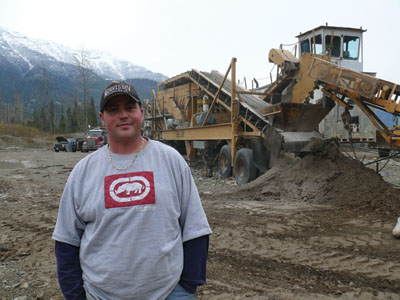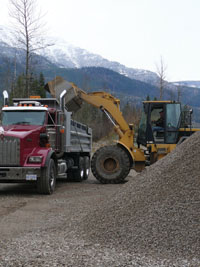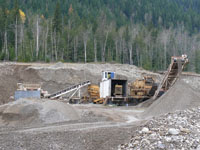
A couple of years ago there were days when Skeet Podrasky wondered why
he came to work. The owner of Morrissey Aggregates Ltd. was struggling
with raw materials that are high in moisture content and clay.
In the aggregates business, the material you have to work with can play a significant role in a company’s success
A couple of years ago there were days when Skeet Podrasky wondered why he came to work. The owner of Morrissey Aggregates Ltd. was struggling with raw materials that are high in moisture content and clay. It was a combination that made for a sticky situation and created binding and clogging problems for the traditional woven wire screen media he was using in his portable crushing plant.
“It was really impacting our production volumes and our ability to meet the specifications required by the engineers as the clogged screens were ineffective and didn’t allow us to get all of the dirt out of our product,” Podrasky explains from his Fernie, B.C., aggregates operation. “I used to work for a company that crushed rock for the B.C. government and we would just go from pit to pit all around the province, so if you had a difficult site, you were only there for a short time and would move on. But here, we own the pit, so we can’t just pick up and move. We have to make the best of what we have, and we have to make it work.”
 |
| Skeet Podrasky (above) of Morrissey Aggregates says switching to Flex-Mat 3 screens is an investment that has paid off. (Photo by Rebecca Edwards) |
Podrasky came to Morrissey Aggregates about three years ago to help his grandfather, Vince Nohels. “My grandfather started out in the logging business in 1949 and then went into heavy equipment and aggregates in 1955,” notes Podrasky. “With my past experience in crushing rock, it was a natural fit for me to join him.”
Podrasky, who initially started a post-secondary education that would send him in the direction of engineering, says working with his grandfather was a great experience. “He passed away last year, but I learned something from him every day and I am really glad I had the opportunity to work with him,” he says.
New Screens
It was with his grandfather’s help that Podrasky started to look at options for their screening issues. “We tried numerous solutions, including different types of self-cleaning screens, but they just didn’t do it for us with the material we had to deal with,” he says, adding that maintenance was a huge issue as removing the clamped-in screens to clean them was extremely time consuming. “Then in 2008 at the ConExpo show, we saw the Major Wire booth and the Flex-Mat 3 tensioned screen media. Initially, we didn’t try the Flex-Mat 3 product as it was more expensive than other screens, but after a followup from Major Wire’s Calgary representative, EIrus Aggregate Systems, we decided to give it a go and we haven’t looked back since.”
 |
|
| Product from Morrissey Aggregates in Fernie, B.C., is loaded into a dump truck for delivery to a local customer. (Photo by Rebecca Edwards)
|
According to Major Wire, the Flex-Mat 3 self-cleaning screen media uses stainless steel with polyurethane strips to bond the individual wires, allowing them to vibrate independently at different frequencies. This creates more screening action, allowing properly sized material to fall through rather than sticking to the wire. The company says throughput can be increased by up to 40% while screen capacity can be increased by 30%.
“What I can tell you from our experience is that we paid more for the Flex-Mat screens than we paid for our other screens, but we have had one screen on our jaw for almost three years and we have put 400,000 tonnes of material over top of it and it still does what it is supposed to do,” says Podrasky. “Since we installed the first Flex-Mat screen we have put them on other equipment as well and we haven’t had to replace a screen yet. It was a fairly major investment for a smaller company like ours, but it has saved us money in the long term, and more importantly, we have been able to achieve higher production volumes and sell our product to more companies because we can meet the specifications required.”
In real numbers, Podrasky says the improvements really depend on the day and the weather. “We see a significant increase in production most days compared to what we would do with our old screens, but on a wet day, it’s a 100% increase because we would have been shut down and parked in the past due to everything clogging up. Now we can still run.”
Podrasky says the Flex-Mat 3 product is also easy to install. “You have to get exact measurements and then they essentially custom make the screens to fit your equipment,” he explains. “Our equipment is mainly from the 1970s so there’s nothing standard about it. The screens are delivered flat on pallets and you simply attach them to the inside deck rails. They come with detailed step-by-step instructions so you can’t really go wrong.”
 |
|
| High clay and moisture content was causing screening issues for Morrissey Aggregates in Fernie, B.C. They fixed the problem with new screens. (Photo by Rebecca Edwards) |
Production Flow
Morrissey Aggregates can crush and screen 150 to 450 tonnes of product per hour, depending on the material and the specifications. The company’s portable plant works in the pit and is moved around as necessary to maximize production, although Podrasky says they will typically set up in one spot and then work through the entire bank of material that is closest to the plant. They use a Cat D7 dozer and a Cat 320 excavator to strip most of the material and then three Cat 950 wheel loaders and a Cat 966 wheel loader load the plant.
The material is fed into the plant’s feeder and then a conveyor belt delivers it to the first Flex-Mat 3 screen. Next in line is a Pioneer jaw crusher, which breaks up the boulders. The broken up material is then directed up more belts before being screened again and sorted. The final step is an LJ Roller Cone 2 finishing crusher, which features a closed circuit deck that circulates the crushed material until it reaches the specified size. The four Cat loaders load the finished material into the company’s two 2009 Kenworth T800 dump trucks with pup trailers for delivery of the finished product to customers.
Morrissey Aggregates, which employs five people including Podrasky, serves customers in B.C.’s southeast, primarily in the Elk Valley. The company produces material for roadbuilding and landscaping, including decorative rock and sub base material.
“We’re not a huge operation,” says Podrasky. “But now we can consistently produce the materials our customers require, and that has been great for our business.”
Print this page